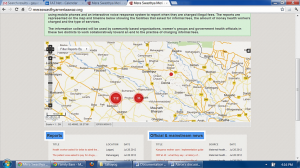Guest post by Averting Maternal Disability and Death (AMDD) and SAHAYOG
Despite the investment of enormous resources by India’s central government and the Uttar Pradesh state government in creating demand for facility childbirth and ensuring free maternity care, requests for informal payments by providers and consequent denial of care persist. The government states that they are unable to take action on informal fees, as they have no hard evidence of their frequency. Informal fees pose an important barrier to reaching quality universal health coverage.
In response, SAHAYOG, a grassroots women’s health and rights organization based in Uttar Pradesh, in collaboration with the Averting Maternal Death and Disability (AMDD) Program at Columbia University’s Mailman School of Public Health, launched the “My Health, My Voice” project in January of 2012. The project uses interactive voice response (IVR) and mobile phones to report requests for informal fees. SAHAYOG has publicized the project through brochures, community meetings, and announcements painted on buildings.
Since the project launch, women have called in over 1100 reports of informal fees. More than half of these reports are for fee requests exceeding 500 rupees (about 8 USD). The reports are mapped in real time on a website that uses Ushahidi, an open access software platform that was created to track election violence in Kenya and is now used for many different types of transparency efforts. The hotline also includes an emergency number that goes directly to the mobile phone of a partner women’s group. This emergency number was essential as there were approximately 20 calls related to denial of emergency care. The partner organization followed up immediately, resulting in immediate attention being given to the women.
 Thus far, SAHAYOG and AMDD have culled some key lessons from ongoing monitoring and evaluation:
Thus far, SAHAYOG and AMDD have culled some key lessons from ongoing monitoring and evaluation:
- User experience: Women felt safe making reports using the My Health, My Voice because their reports were anonymous and untraceable. And, because the reports did not place blame on an individual health worker, women felt that they could safely return to the health facility in the future to seek services without retaliation. Among the possible modes of mobile phone communication, IVR is significantly more accessible than text. Many of the most ubiquitous phones support Roman text only, making text less accessible in settings where the primary language (such as Hindi) does not use Roman letters. Despite IVR’s advantage in using voice rather than text, SAHAYOG learned that significant assistance and mobilization was still required to ensure use of the hotline. While many people own mobile phones, it may be that men use the phones more frequently than women.
- Motivations behind usage: In some communities, SAHAYOG worked with grassroots women’s organization. Those health centers which are closer to and used by members of these organizations had far higher levels of reporting than others. This indicates that higher levels of awareness and desire to improve the health system are important in motivating users to report grievances, especially when there will be no personal compensation provided to those who report paying informal fees.
- Publicizing the hotline: The awareness-raising campaign was resource intensive. However, it played a key role in increasing women’s knowledge of their entitlements and in publicizing the project. Many stakeholders feel that additional resources should be put into campaigning so that all primary health care facilities are included. This could include hiring more campaigners to travel to the centers and using other media, such as community radio.
- Quality improvement and policy change: The data generated by the platform can be used by health facility managers as a tool to monitor health facilities’ performance. The data can also be used as an indicator to track quality improvement efforts, which one facility covered by the project has already done. Further, with careful negotiation by SAHAYOG, the Uttar Pradesh and district governments see the My Health, My Voice project as something that helps them to accomplish their goals, rather than as an adversarial outside intervention. However, support and advocacy are required to ensure that the results are used by the government. In general, while the data and maps were publically available, program managers and government officials only looked at them when SAHAYOG presented it to them.
For more information on the technical set up of the project, including the internet, IVR, and Ushahidi requirements, please see a brief detailing the set up and lessons learned here.
Do you have an opinion on the role mHealth can play to improve maternal health? What do you see as the biggest advantages of mHealth? The limitations? If you are interested in submitting a blog post for our ongoing guest blog series on mHealth for Maternal Health, please email MHTF Research Assistant Yogeeta Manglani at ymm108@mail.harvard.edu.
